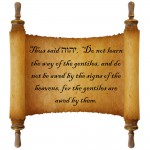Introduction
 In the previous installment of this series, we started our journey. As discussed in the preceding article, we will take a top-down approach. In the first article, we looked at what the Bible is. Now we will deep one level lower into the books of the Bible. Then in the next article we will study the phrases or passages that make up a book.
In the previous installment of this series, we started our journey. As discussed in the preceding article, we will take a top-down approach. In the first article, we looked at what the Bible is. Now we will deep one level lower into the books of the Bible. Then in the next article we will study the phrases or passages that make up a book.
Last time we looked a bit into the history of the Bible texts. We also had a more detailed look at the different Bible translation and why we have these. Hopefully, you would now have become a bit more informed about the specific translation of Bible you use. You will also know what is the translation approach that was followed and who did the actual translation.
Now that we are acquainted with the Bible we are reading we also need to become a bit more familiar with the books that make up our Bible. We already mentioned the canon of the Bible in the previous article. Now we need to get to the individual books that make up the Bible.
Order of the books
The first, and most important, point regarding the canon of the Bible is the fact that these books are not arranged in a chronological sequence This implies that they should not read like a story book. You do not read from Genesis to Revelation as one sequential story line. Good example, we know that Ezra and Nehemiah returned to Jerusalem long after most of the minor prophets had lived. Thus, when studying the book of Nehemiah, it is important to know that a prophet like Joel had already lived and prophesied before Ezra returned to Jerusalem.
We need to know that the compilers of the Bible used some logic to sequence the books, but this was not chronology. When you look at the Epistles of Paul, note that they are not in the sequence that Paul wrote them. The epistles are currently sequenced in our Bibles mainly based on the size. This could lead to some serious confusion if you are trying to understand how Paul’s viewpoint on a specific topic matured over time. His works were written over a long span of time. We know that he did alter or expand some of his views over time.
Below you will see an attempt to place the books of the Bible in a chronological sequence. 5
| 01 – Genesis | 21 – Jonah | 40 – John |
| 02 – Job | 22 – Hosea | 41 – Mark |
| 03 – Exodus | 23 – Amos | 42 – Matthew |
| 04 – Leviticus | 24 – Isaiah | 43 – Luke |
| 05 – Numbers | 25 – Micah | 44 – Acts |
| 06 – Deuteronomy | 26 – Zepheniah | 45 – Galatians |
| 07 – Joshua | 27 – Jeremiah | 46 – James |
| 08 – Judges | 28 – Nahum | 47 – 1 Thessalonian |
| 09 – Ruth | 29 – Habbakuk | 48 – 2 Thessalonian |
| 10 – 1 Samuel | 30 – Daniel | 49 – 1 Corinthians |
| 11 – 1 Chronicles | 31 – Ezekiel | 50 – 2 Corinthians |
| 12 – Psalms | 32 – Lamentations | 51 – Romans |
| 13 – 2 Samuel | 33 – Obediah | 52 – Ephesians |
| 14 – 1 Kings | 34 – Ezra | 53 – Colossians |
| 15 – 2 Chronicles | 35 – Haggai | 54 – Phillipians |
| 16 – Proverbs | 36 – Zechariah | 55 – Philemon |
| 17 – Songs | 37 – Esther | 56 – 1 Timothy |
| 18 – Ecclesiastes | 38 – Nehemiah | 57 – Titus |
| 19 – 2 Kings | 39 – Malachi | 58 – 2 Timothy |
| 20 – Joel | 59 – 1 Peter | |
| 60 – Jude | ||
| 61 – 2 Peter | ||
| 62 – Hebrews | ||
| 63 – 2 John | ||
| 64 – 3 John | ||
| 65 – 1 John | ||
| 66 – Revelation |
A Survey of the books of the Bible
In order for us to have a correct interpretation of any phrase of verse in the Bible, it is always vital to have the text within the right context – context is king! What does this mean? This means we need to know things about the text that is not part of the text itself. The context of the text has many dimensions we need to keep track of. These include:
- Who wrote it?
- Who was the intended recipient of the message?
- Why was it written?
- When was it written?
All these questions would give us a bit more background information. This background information helps us to interpret the text even more accurately. However, this means we have some pre-work to do before we start studying a specific verse. We need to know more about the book. In order for us to be able to do this, we can use a specific technique in Bible study. The technique is called “A Survey” of the book.
There is no fixed method for doing a survey, but most of the surveys that I have seen seem to overlap in content and approach. What is important from this technique is that it opens our eyes to sources of information. We will need this later when we start to interpret the different dimensions of each text. In order to be able to understand all the relevant dimension we need to know about the background of the book.
Who wrote the book?
This is the question that has a very obvious answer in a lot of the cases. However, in some of the books, the author is not always that clear. Let us discuss some examples.
The Epistle to the Hebrews does not state the name of the author. Thus, we need to look at the content of the book to try to determine whose pen this book came from. Currently, we have a number of theories on the table for this answer. The first one is consistently that Paul is the author. The counter argument is always: “In all other books Paul mentions his name, why make the exception here?” If we look purely at the facts, we can only conclude that the author was somebody who lived within the same time period as Paul, and knew some of the people known to Paul. Anything more than that is interpretation. I personally do not think that Paul is the author of Hebrews, thus I do not try to link the theology of this book with the way that Paul thought. Lots of people will differ from me on this point.
The next type of debate is around the book of Deuteronomy. As mentioned in my post about the Altar of Joshua, a lot of academics have put forward the theory that the book was written much later. This would imply that Moses was not the real author of the book. The alternative theory states that it was written by a historian / chronologist much later. One specific theory states that it was a forgery that was used in the time of King Josiah. The priests then discovered this scroll and presented it to the king (2 Kings 22:1) The arguments used to support this theory:
- The book was written after the nation had crossed the Jordan
Deuteronomy 1:1
1 These are the words which Moses spoke to all Israel across the Jordan in the wilderness, in the Arabah opposite Suph, between Paran and Tophel and Laban and Hazeroth and Dizahab.Deuteronomy 1:5
5 Across the Jordan in the land of Moab, Moses undertook to expound this law, saying,
- How could Moses write about his own death?
Deuteronomy 34:5–6
5 So Moses the servant of the Lord died there in the land of Moab, according to the word of the Lord. 6 And He buried him in the valley in the land of Moab, opposite Beth-peor; but no man knows his burial place to this day.
We find in many books that the words and messages are from one person, but the physical composition of the text was done by a scribe (copywriter). This is the same today, most marketing material is not written by an employee of the company that produces the product. The content of the message still originates from within the company. We also have professional editors who will rewrite large parts of any manuscript before it is published. These editors do not claim authorship of the works they edit. For me, this separation between authorship and penmanship does not detract from the value of the message. The ideas and facts are still from the person we see as the “author.”
This information would enable you to understand the personality behind the writings better. If you understand the person better, it is always easier to grasp what they are trying to convey.
A note of warning – Higher Criticism
Who was the intended recipient of the message and why was it written?
Once we know who the author or owner of the ideas /messages are, we need to get to the objective of the writing. Why was this written? In most cases, a big part of the answer lies in the intended receipts of the message. If we know who was going to read the document, we can also find out why they wrote it.
In some cases, especially the Epistles, we have the intended audience unmistakably indicated in the text. We also see in the Gospel of Luke and the Acts of the Apostles the original intent of the document clearly indicated. I do not believe that anybody would have any doubt as to the objective of the books of Kings, Chronicles and Samuel. They are clearly recording of the history of the nation of Israel.
When was it written – the historical context
If we know the author and the intended recipients, we need to start looking a bit wider for more context. One of the areas we could use is the historical context of the book. What was happening at that time that may influence what was written? This implies that we also need to start looking outside the Bible for facts. We have a lot of material outside the Bible that can help us what was happening in the world at this time.
Please find below a table that gives a number of historical documents that you could use 2.
|
Author |
Date |
Title of Work |
|
Herodotus |
Ca. 484–425 B.C. |
The Histories |
|
Thucydides |
Ca. 460–400 B.C. |
The History of the Peloponnesian Wars |
|
Xenophon |
Ca. 430–355 B.C. |
Anabasis, Cyropaedia, Hellenica, Memorabilia |
|
Polybius |
Ca. 203–120 B.C. |
Histories |
|
Strabo |
Ca. 64 B.C.–A.D. 24 |
Geography |
|
Philo of Alexandria |
30 B.C.–A.D. 40 |
Allegories of the Sacred Law |
|
Flavius Josephus |
37–97 A.D. |
Antiquities of the Jews, Bellum Judaicum |
|
Tacitus Ca. |
 58–120 A.D. |
Germania, Historiae, Annals |
|
Suetonius |
Ca. 69–140 A.D. |
The Twelve Caesars |
|
Eusebius |
Ca. 263–340 A.D. |
The Life of Constantine, Ecclesiastical History |
Other contextual elements
The type of literature
While reading and interpreting a specific book of the Bible, we also need to take note of the genre of the book. Basically, what this means is that different books take on distinct forms of literature. Today we have novels, autobiographies, science fiction and a lot of other. If you read a science fiction book believing that it is an autobiography, you may end up really confused. The same principle applies to reading the books of the Bible.
We have different styles of literature, called genre. Let me explain a couple of the more common ones:
- Narratives – this genre includes chronicle, list, saga, and novelette. These are normally used to describe historical aspects of a story. Example – Genesis, Deuteronomy, Ezra and Nehemiah
- Biography – this genre can be defined as “a discrete prose narrative devoted exclusively to the portrayal of the whole life of a particular individual perceived as historical.â€4 Example – Job
- Wisdom Literature – Here we include items like psalms, hymns, proverbs, saying and disputation. Examples – Psalms, Proverbs and Song of Songs
- Prophecy – these include the oracle and judgment speech of a specific prophet or seer. Examples – Amos, Jona, Jeremiah, and Zechariah.
- Gospel – A gospel can be categorized as a subset of biography, but its uniqueness consists in being teaching regarding the salvation by Y’Shua or preached biography. Examples – Gospels of Matthew, Mark, Luke and John.
- Epistles – The letters or communications sent to a specific community of believers to address one or more topics relevant to the target audience. These letters were normally circulated to other communities as well. examples – the books of Paul, Epistle to the Hebrews.
- Apocalyptical – These are books that describe the end of times. These are normally very symbolic and revelatory in nature. Examples – Daniel 7-12, Ezekiel 37-48, Zechariah 9 –14 and The Revelation of John.
As you can see from my examples, one book may contain a number of genres. The first five books (the Pentateuch) are mainly narratives including long chronicles and many lists of census, places visited, etc. Yet within these books we find wisdom literature – Deut 32 as well as prophecy Deut 33.
As you become more familiar with these topics, you should later look a bit deeper to understand more of the literary construct being used within these forms, eg. Parables within Gospels.
Where to start
References
- Smith, James E. The Pentateuch. 2nd ed. Old Testament Survey Series. Joplin, MO: College Press Pub. Co., 1993.
- Archer, G., Jr. (1994). A survey of Old Testament introduction (3rd. ed.) (25). Chicago: Moody Press.
- Harris, R. Laird. Exploring the Basics of the Bible. Wheaton, IL: Crossway Books, 2002.
- David E. Aune, The New Testament in Its Literary Environment (Philadelphia: Westminster, 1987), p. 29.
- Elder T W. Exploring Creation [Internet]. Livingston (TX): 2011 Apr. 6. Accessed 11-11-2012. Available from: http://www.exploringcreation.info/scripture/books.htm









Leave a Reply